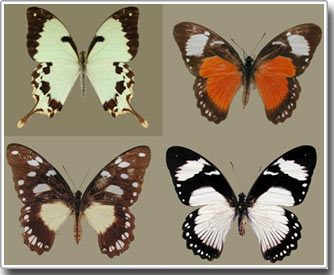The secret of the disguise of the tailed butterfly is in the gene
Scientists have published research results on the identification of a gene that helps a harmless butterfly in Africa chase the enemy with butterfly patterns and colors like poisonous species.
Papilio dardanus Papilio dardanus is an unusual animal because the cocoon-busting pupa has a multitude of different wing patterns and colors. This makes them different from other butterflies because these species are identified by their wing patterns and distinctive colors. Moreover, some of the butterfly motifs are similar to those of other poisonous species, helping them to have a valuable camouflage to drive away predators.
Biologists are excited to find out exactly how the wing pattern is determined in the tailed butterflies, because they believe that understanding the patterns of evolutionary simulations will reveal changes. evolutionary happens step by step or boom.

Females have numerous wing patterns similar to those of poisonous butterflies (Photo: Physorg)
In the 1950s, scientists found that there must be a decisive mechanism for gene transfer, so countless textures are different on each individual tailed butterfly but so far it has not been identified. or its location.
The new work presents the process of biologists using molecular and DNA sequences to determine the genetic code that determines patterns and colors.Research suggests that a growth gene, linked to the development of butterfly embryos, is the key to the secret behind different motifs on butterfly wings .
Professor Alfried Vogler, Faculty of Life Sciences of the Royal College of London and the Museum of Natural History and belonging to the author's group, explained that more research is needed to clarify how this gene works: 'We have taken an important step in determining exactly how insects are favored by nature for extremely useful suits. However, identifying the gene sequence involved in this process is only the first step - we need to go into details about the difference in that gene and another gene that is located right next to exactly how genes that form patterns. '
Professor stressed on the importance of studying the tailed butterfly: 'One might argue that a species that evolves gradually to mimic poisonous butterflies over generations is useless - the camouflage layer only Really useful when fully developed. This may represent the ability to make sudden strides in evolution, an extremely interesting finding. By studying changes in gene sequences, we will know if this happens or not. '
Common tailed butterflies in sub-Saharan Africa have wing widths ranging from 8.8 to 10.7 cm. Only the females own the wing pattern similar to other butterflies. All males are yellow with many black streaks and tails typical of swallowtail butterflies.
- This butterfly with transparent wings will one day save our eyes
- Discovered genes controlling colors and patterns on butterfly wings
- Do you know where the butterfly's ear is?
- There are unusual butterflies in Fukushima
- Butterfly's wicked secret
- Butterflies disguising themselves as tigers threaten enemies terribly
- 'Giant butterfly' was discovered in Malaysia
- Wild colors
- Butterfly Emperor faces the threat from humans
- Discovering extremely rare butterflies
- Huge butterfly
- Fragile like butterfly wings, what will their fate be when the rain comes?
 Why do potatoes have eyes?
Why do potatoes have eyes? 'Tragedy' the world's largest carnivorous life: Death becomes ... public toilet
'Tragedy' the world's largest carnivorous life: Death becomes ... public toilet Tomatoes were once considered 'poisonous' for 200 years
Tomatoes were once considered 'poisonous' for 200 years Detecting microscopic parasites on human face
Detecting microscopic parasites on human face